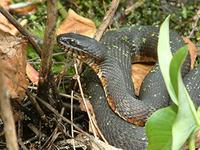Northern Water Snake

This thick-bodied snake is quite variable in color and pattern. Background color ranges from light gray to dark brown. It is almost always patterned with reddish-brown, brown or black cross bands
near the head and alternating back and side blotches farther down the body. The pattern generally becomes less noticeable as the water snake grows larger, and often results in a uniformly dark snake. Body scales are strongly keeled and the belly is patterned with black or orange crescents.

Courtship and mating typically occur in May and Jne, and females give birth to 20-40 young in August and September.
True to their name, water snakes are found in a variety of wet habitats including lakes, ponds, rivers, streams and wetlands. They are excellent swimmers, both on the surface or submerged, and commonly forage along the water’s edge for prey. Fish, frogs, tadpoles and salamanders make up the bulk of their diet, though they will also take small mammals, birds, insects, crayfish and other invertebrates. Water snakes are very common and can often be found basking on beaver dams and lodges, bridge abutments, banks and shrubs. In the spring, water snakes are commonly reported by homeowners who find them in their backyards. When threatened, they rapidly retreat to water. If cornered, they do not hesitate to strike. Water snakes can almost always be counted on to bite, defecate and spray a particularly foul-smelling musk when handled.


nockedup Massachusetts outdoors.